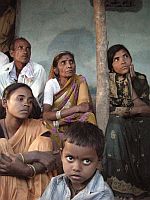Thursday, April 18, 2024
News and Views from the Global South
DEVELOPMENT-INDIA: Two Villages, Two Very Different Stories
Jaideep Hardikar*
- It is hard to find smiling farmers in Dorli, rural Vidarbha, a cotton growing belt in western India’s Maharashtra state.

Nanda Bhandare (top, extreme right) took her children out of school after her cotton farmer husband committed suicide Credit: Jaideep Hardikar/IPS
Hol village, about 1,000 km west, is lush-green. The fields are studded with sugarcane, maize, chikoo (fruit), green chillies and beans. The village is 30 km west of Baramati, the unchallenged bastion of India’s Agriculture Minister Sharad Pawar.
A network of serpentine canals and village ponds provide water for agriculture and dairy farming. "Water is a must," asserts Prahlad Karche. "If you have water and allied business, farming is viable," the 65-year-old farmer says as he takes visitors around his three-acre farm where he also has four Jersey cows that yield 60-70 litres of milk daily. "You need water to grow fodder for them round the year," he explains.
The Karches are small farmers. But compared to their counterparts in Vidarbha they are prosperous.
Cotton farmer Dharmapal Jarunde owns five acres in Dorli, 16 km from Wardha town. His land is unirrigated, and totally reliant on rain. "We grow only one crop," he says. Two years ago, the village put itself up for sale. With incomes shrinking and debts rising, families were desperate. But no one came forward. "Who will buy our unproductive land!" rues Jarunde.
A 100 km away in Amravati district, the village of Sheoni Rasulapur had a board, ‘Kidneys for sale’, in 2005. That year the government had withdrawn institutional support for cotton farmers, driving cash-strapped cultivators into distress. By offering to sell their kidneys, the village made a futile attempt to raise money to feed their families.
"We won’t earn even 10,000 rupees (250 US dollars) a year from our seven acres," says Nanda Bhandare, in Kelapur tehsil of Yavatmal district, sitting in the cramped, one-room mud hut, where she lives with her old mother-in-law and two children. Her son, 12, and daughter, 10, dropped out of school after her husband’s death, to help on the farm.
Vidarbha’s cotton fields have turned hundreds of children into child labour, forced to replace hired labour on family farms.
The cotton farmers are doomed. If the rains play truant, as they did for three years from 2001 to 2004, the losses are huge. Add to that the price volatility in global markets. "That has been the story since 1995," says farm expert Vijay Jawandhia. "Farmers cannot fight two enemies, the climate and unpredictable markets, without help from the government,"
"If we get assured irrigation, things will change here," says Jarunde, optimistically. Hol and Dorli are two extremes within Maharashtra.
In canal-fed western Maharashtra, a survey by the state’s planning board found over 2.7 million farmers earned an annual income of 75,000 rupees (1,875 dollars) and above. The same number of farmers in Vidarbha earn less annually.
Western Maharashtra comprises Pune revenue division with six districts, and Ahmednagar in the Nashik revenue division. It has a population of 25 million – some 15-16 million of whom depend on farming. Roughly 300,000 farmers cultivate cane.
Vidarbha on the other hand comprises 11 districts spread over two revenue divisions, Nagpur and Amravati. While the former is mostly paddy farms, the latter is cotton. Over half of Vidarbha’s roughly 3.5 million landowners grow cotton.
In fact, according to a 2005 door-to-door survey carried out by the government of Maharashtra, one million farm households – or five million people – are in "acute to moderate" distress in Vidarbha. The situation has only worsened.
In mid-2006, when farm suicides made national headlines, Prime Minister Manmohan Singh toured Vidarbha and announced a "relief package". Six months before him, Maharashtra’s chief minister had announced a 268 million dollars package for Vidarbha. Together, 1.4 billion dollars have been allocated for the region, but relief plans are skewed. Even the 210 million dollars interest waiver on outstanding loans has helped cooperative and national banks more than the distressed farmers.
"The biggest beneficiaries of the two packages are bureaucrats and politicians," comments Kishor Tiwari of the Vidarbha Jan Andolan Samiti, a farmers’ organisation based in Yavatmal. "These are all a repackaging of old and new schemes, and not a fresh budgetary allocation. There has been no focus on income generation," he declares.
Sudhir Goel, a senior government official who is secretary to the cooperation department, acknowledges the regional disparity. "There is a huge gap mainly due to the presence of cooperatives in one region and lack of it in the other. Plus, the economy of allied sectors in western Maharashtra brings additional income to farmers there," he explains.
Typically sugar cooperatives have between 20,000 and 30,000 members each. Every cane farmer is a member of the local mill, which procures the produce every year at a ‘support’ price. Even dairy farming and horticulture, both in the allied sector, are run on the cooperative model.
Take for instance, the successful Warana cooperative complex in Warana Nagar, Kolhapur district, western Maharashtra. It comprises a sugar mill, flourishing milk processing society, bank and retail chain, valued at a whopping 250 million dollars. Vidarbha’s backwardness is the result of low investments in irrigation, insists Madhukar Kimmatkar, a former Congress party minister who has closely studied the disparities in farming. Only three percent of land in six of the worst affected districts is irrigable.
Kimmatkar, member of the Statutory Development Board for Vidarbha set up in the 1980s, has lobbied to raise the annual budget outlays for the crisis-plagued region. "Even a fluctuation in the monsoon or market prices is enough to crush the farmer," he says. "There has to be more investment in irrigation."
(*This is the first story in a series on the role of subsidies in Indian agriculture.)

 Print
Print



